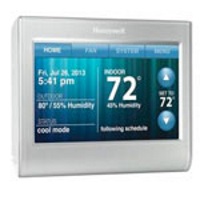Tips for Managing Indoor Humidity with Thermostat and Ventilation
Alabama is only a week into spring, but even mild humid weather often requires running the central air conditioning system long enough to remove excess humidity. We like the Honeywell Wi-Fi Smart Thermostat because it has a bright, easy to read touch screen that shows both temperature and humidity. You can’t manage what you don’t measure, so this thermostat is unique. It will also display outdoor temperature and humidity so you can easily see if opening the windows are the solution to indoor comfort. If you already have a programmable thermostat, another strategy is a stand-alone indoor thermometer and humidity display, which can be placed in the room you want to monitor.
Maintaining indoor humidity between 40% and 60% is essential for comfort and health reasons. High humidity can lead to mold, mildew and insect problems. Running the air conditioner just long enough to remove the excess moisture is easy to do, just lower the thermostat set point one or two degrees. You should also manage indoor humidity is by controlling it at the source — run the kitchen vent hood when cooking (it should exhaust to outside the home) and let bath fans run for at least 20 minutes after showering. Crawl spaces are also a source of moisture and radon pollution. If your duct system is located in the crawl space, be sure to seal gaps between the duct boot and floor to minimize air transfer from the crawl space into your home.
A correctly programmed thermostat will save energy by setting back the heating and cooling when you are away or asleep. This handy online calculator from Honeywell will estimate your savings based on zip code and set points. It doesn’t account for home size or other important factors, but it’s a useful tool for demonstrating that managing your heating and cooling system is the most effective way to save money and improve indoor comfort.


Comments are closed.